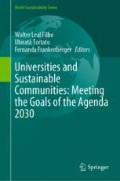Abstract
Making cities and human settlements inclusive, safe, resilient and sustainable is a goal of sustainable development (Sustainable Development Goal 11, SDG 11). To achieve sustainable cities, urban planning of natural spaces must contribute to deal with the socioenvironmental challenges brought by urbanization. However, planning strategies for green infrastructure are frequently skewed toward ecological aspects. Such a unidimensional perspective in the development of planning tools may have a poor contribution to social welfare. Therefore, there is a need for integrating the social aspects to achieve effective planning, and to recognize the social contributions of green infrastructure. The objective of this study is to diagnose the functions and dysfunctions of green infrastructure, as well as its contributions to the social welfare in the Metropolitan Zone of Leon, Mexico. The area of study is characterized by an accelerated urban growth in one of the most dynamic industrial regions in the country. The methodology includes an assessment of green infrastructure components of its distribution. An evaluation of welfare-related social context was also conducted. Main results showed that (i) green infrastructure can be a strategic approach for the land sustainability, (ii) the metropolitan area of Leon showed the existence of key green infrastructure components and reveled a fragmented network of natural spaces and (iii) people perceived social and environmental functions and dysfunctions from green infrastructure components. This study has concluded that an effective planning approach to green infrastructure should integrate functions and dysfunctions related to social context. This approach may contribute to create more sustainable cities with benefits for all people.
Access this chapter
Tax calculation will be finalised at checkout
Purchases are for personal use only
References
Álcala L (2007) Dimensiones urbanas del problema habitacional. El caso de la ciudad de Resistencia, Argentina. Revista Invi 22(59):35–68
Austin G (2017) Infraestructura verde para la planeación del paisaje. Interacción humana y sistemas naturales. Trillas S.A de C.V (ed), Ciudad de Mexico
Busquets J, Cortina A (eds) (2009) Gestión del Paisaje. Manual de protección, gestión y ordenación del paisaje (1ra edn). Ariel, Barcelona
Bendict M, McMahon E (2006) Green infrastructure. Linking landscape and communities. The Conservations Fund, United States of America
Calaza P (2016) Infraestructura verde. Sistema Natural de Salud Pública. Ediciones Mundi Presa, España
Calderon-Contreras R, Quiroz-Rosas L (2017) Analyzing scale, quality and diversity of green infrastructure and the provision of Urban Ecosystem Services: a case from Mexico City. Ecosyst Serv 23:127–137
Castro Castro LJ (2018) La Planeación sostenible de ciudades. Propuestas para el desarrollo de infraestructura. Fondo de Cultura Económica, México
Gorm D (2015) Infraestructura verde: una vida mejor mediante soluciones naturales. Boletín de la AEMA, European Environment Agency (EEA (2015/3). https://www.eea.europa.eu/es/articles/infraestructura-verde-una-vida-mejor. Accessed 8 Dec 2018
Gelh J (2013) La humanización del espacio urbano (5ta. edn). Reverté, Barcelona
Hay A (1995) Concepts of equity, fairness and justice in geographical studies. Trans Inst Br Geogr 20(4):500–508
INEGI. Encuesta intercensal (2015). Instituto Nacional de Estadística y Geografía INEGI. https://www.inegi.org.mx/. Accessed 8 Dec 2018
INEGI (2018) Mapa Digital de México. Instituto Nacional de Estadística y Geografía INEGI. http://www.beta.inegi.org.mx/temas/mapadigital/. Accessed 8 Dec 2018
Iplaneg (2018a) Instituto de Planeación del Estado de Guanajuato. Gobierno del Estado de Guanajuato. México. https://iplaneg.guanajuato.gob.mx/?page_id=11. Accessed 8 Dec 2018
Iplaneg (2018b) Plan Estatal de Desarrollo Guanajuato 2040. Construyendo el Futuro. Gobierno del Estado de Guanajuato, Guanajuato, México
Jennings V, Larson L, Yun J (2016) Advancing sustainability through urban green pace: cultural ecosystem services, equity, and social determinants of health. Int J Environ Res Public Health 13(2):196
Lezama JL, Domínguez J (2006) Medio Ambiente y sustentabilidad urbana. Papeles Población 12(49):153–176
Moreno S (2008) La habitabilidad urbana como condición de calidad de vida. Palapa III(II):47–54
Selman P (2012) Sustainable landscape planning. The reconnection agenda. Great Britain, Routledge
Svara J, Brunet J (2005) Social equity is a pillar of public administration. https://www.researchgate.net/publication/249675111_Social_Equity_Is_a_Pillar_of_Public_Administration. Accessed 8 Dec 2018
UN-Habitat (United Nations Human Settlements Programme) (2013) State of the world’s cities 2012/2013 https://unhabitat.org/books/prosperity-of-cities-state-of-the-worlds-cities-20122013/. Prosperity of Cities. Accessed 31 July 2018
UN-Habitat (United Nations Human Settlements Programme) (2017) The new urban agenda. http://habitat3.org/wp-content/uploads/NUA-English.pdf. Accessed 30 July 2018
UN-Habitat (United Nations Human Settlements Programme) (2018) Urban planning and design. https://unhabitat.org/expertise/2-urban-planning-and-design/. Accessed 31 July 2018
Vásquez A, Devoto C, Giannotti E, Velásquez P (2016) Green infrastructure system facing fragmented cities in Latin Amerixa-Case of Santiago, Chile. Procedia Eng 161:1410–1416
Van Assche K, Verschraegen G (2008) The limits of planning: Niklas Luhmann’s systems. Theory and the analysis of planning and planning ambitions. Plann Theor 7(3):263–283
Zoho Corporation Pvt. Ltd. (2018) zoho.com. In: Z. Corporation (ed). https://www.zoho.com/ Accessed 7 al 19 de octubre de 2018
Acknowledgement
This work was supported by UNAM-PAPIIT IA402418.
Author information
Authors and Affiliations
Corresponding author
Editor information
Editors and Affiliations
Appendix
Rights and permissions
Copyright information
© 2020 Springer Nature Switzerland AG
About this chapter
Cite this chapter
Reyes Plata, J.A., Elías Orozco, M., Villaseñor, I.Z.J. (2020). Green Infrastructure and Social Welfare. Lessons for Sustainable Urban Development in the Metropolitan Zone of Leon, Mexico. In: Leal Filho, W., Tortato, U., Frankenberger, F. (eds) Universities and Sustainable Communities: Meeting the Goals of the Agenda 2030. World Sustainability Series. Springer, Cham. https://doi.org/10.1007/978-3-030-30306-8_4
Download citation
DOI: https://doi.org/10.1007/978-3-030-30306-8_4
Published:
Publisher Name: Springer, Cham
Print ISBN: 978-3-030-30305-1
Online ISBN: 978-3-030-30306-8
eBook Packages: Earth and Environmental ScienceEarth and Environmental Science (R0)

